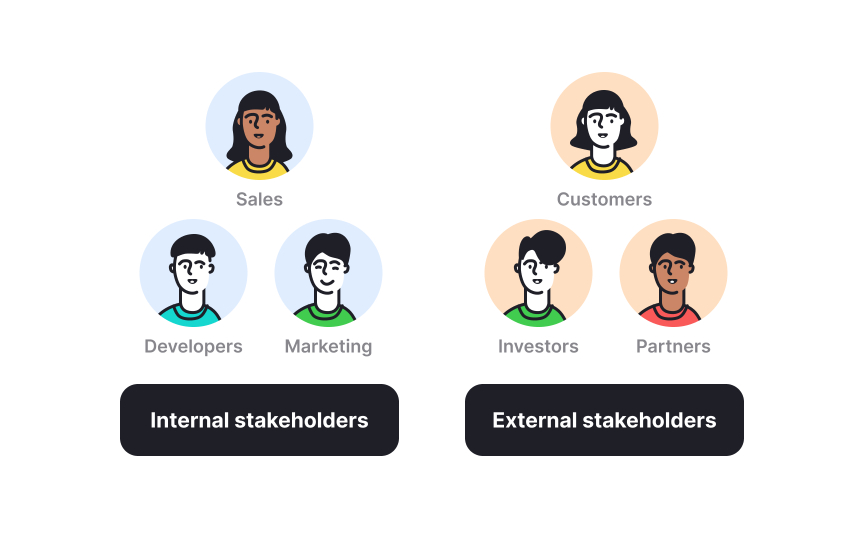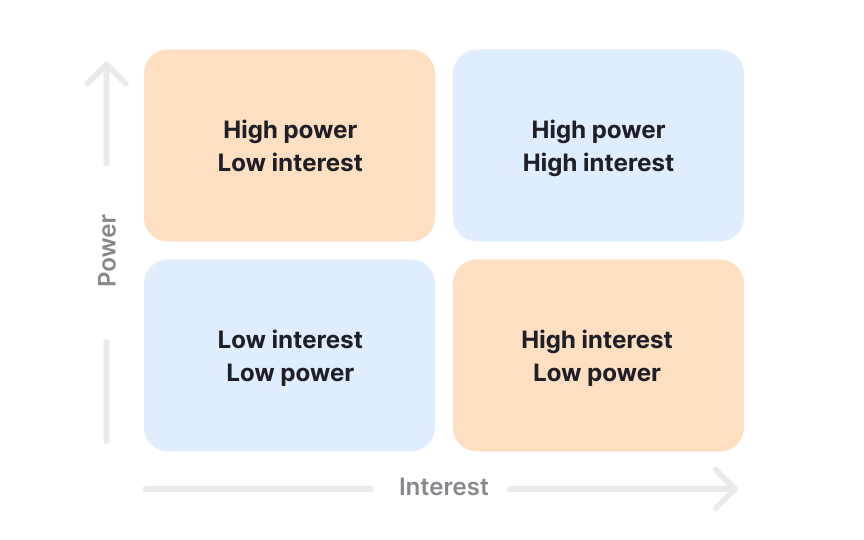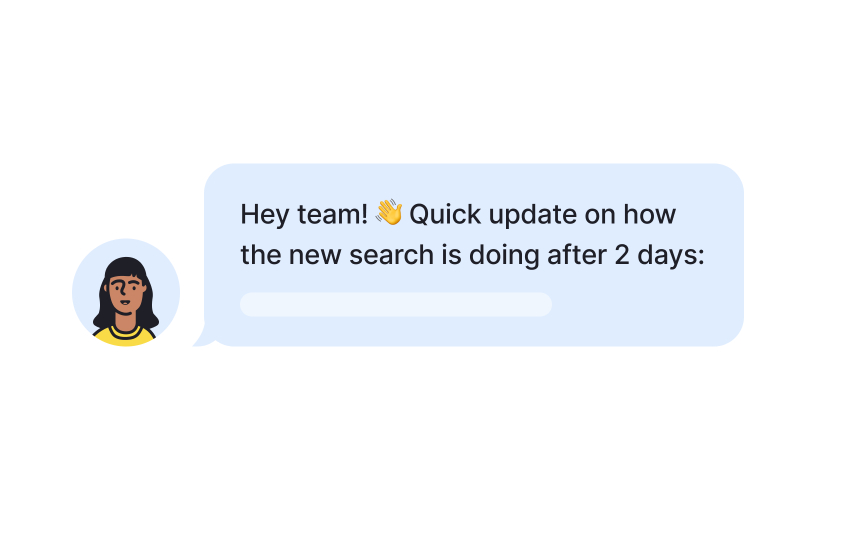Stakeholder Management
Learn essential stakeholder management techniques to align teams and drive product success.
Every product manager knows the challenge of working with different teams and personalities to bring a product to life. Stakeholder management is about building relationships with everyone who has a stake in your product's success, from executives who approve budgets to developers who write the code. These relationships make or break your product. Some stakeholders have the power to greenlight projects, while others contribute essential expertise. Understanding what drives each person, how they prefer to communicate, and what they consider success helps you turn potential obstacles into valuable partnerships.
By mapping who's who, keeping communication channels open, and addressing concerns early, you create an environment where teams work together smoothly. Great stakeholder management isn't just about getting approvals; it's about fostering alignment and collaboration that leads to better products that serve both business goals and user needs. Mastering these skills helps you navigate organizational complexity and keeps everyone moving in the same direction.
Stakeholders are individuals or groups who can affect or are affected by your product decisions. They may have direct decision-making power, provide necessary resources, or be impacted by the product's success or failure. As a
- Internal stakeholders include executives, engineering teams, sales, marketing, customer support, and other product teams.
- External stakeholders might include customers, investors, regulatory bodies, and partners.
When identifying stakeholders, consider who has formal authority over your product, who controls resources you need, who will implement your decisions, and who will be affected by your product. Think beyond the obvious direct stakeholders to include those who might have indirect but significant influence. Remember that stakeholder landscapes change over time. New stakeholders emerge as products evolve, organizational structures shift, or market conditions change. Regularly revisiting your stakeholder map ensures you're engaging with the right people at the right time.[1]
The stakeholder power-interest matrix helps you prioritize your efforts with different stakeholders. This tool maps people based on 2 factors: their power (ability to influence your product) and their interest (how much they care about your product). This matrix divides stakeholders into 4 groups, each needing a different approach:
- High-power, high-interest stakeholders are your key players. They can greatly impact your product and care deeply about it. These people need close attention and regular communication. Examples include executive sponsors and engineering leads.
- High-power, low-interest stakeholders have influence but aren't involved day-to-day. Keep them satisfied with updates that don't overwhelm them with details. Senior executives often fit here.
- Low-power, high-interest stakeholders lack authority but care about your product. Keep them informed and use them for feedback. This might include support teams or certain users.
- Low-power, low-interest stakeholders need minimal engagement. Monitor them occasionally but focus your energy elsewhere.
A stakeholder's position can change over time, so update your matrix regularly as your product evolves.[2]
Pro Tip: When creating your matrix, consider both formal authority and informal influence. Some people impact projects through their networks or expertise rather than their official role.
As a
- Executives focus on strategic vision and business outcomes
- Engineering teams value technical feasibility and clear requirements
- Sales teams want products with compelling selling points
- The marketing team needs clear value propositions
To identify stakeholder motivations, consider their role, responsibilities, and how your product affects their work. What does success look like for them? What problems keep them up at night? What metrics do they track? Sometimes, motivations aren't obvious, so you'll need to ask good questions and listen carefully.
Once you understand what drives your stakeholders, you can frame your product in terms that resonate with them. When speaking with executives, focus on strategic goals and ROI. With engineers, discuss technical challenges and solutions. For sales, highlight competitive advantages and customer benefits. Remember that stakeholders may have hidden agendas or conflicting priorities. Building trust through consistent, transparent communication makes it more likely that stakeholders will share their true concerns and motivations.
Pro Tip: Create a simple chart for key stakeholders noting their primary goals, concerns, and preferred metrics. Reference this before important meetings to ensure your communication aligns with their priorities.
Picking the right ways to communicate with stakeholders is key to managing them well. Even great information can miss the mark if it's shared in a way stakeholders don't connect with:
- Purpose: Different methods work for different goals. Formal approaches (written requirements, presentations, reports) create clear records and explain complex details. Informal methods (conversations, quick chats, emails) allow for faster feedback and help build relationships.
- Frequency: Consider how often each stakeholder needs updates. Some need daily check-ins, while others prefer weekly or monthly updates. Too many messages can be just as bad as too few.
- Format: Visual tools like dashboards, roadmaps, and diagrams make complex information easier to understand. These visuals help stakeholders quickly see the product's status, connections between parts, and future direction.
Remember that good communication works both ways. Create chances for stakeholders to share their thoughts, not just hear from you. This keeps them engaged and lets you benefit from their knowledge.[3]
Building trust with technical and development teams requires specific approaches that respect their expertise and address their unique concerns.
- Demonstrate respect for technical expertise and UX: Engineers and designers value their professional knowledge. Acknowledge their expertise and avoid dictating how they should implement solutions. Focus on the "what" and "why" rather than the "how."
- Be transparent about priorities and changes: Development teams need to understand why priorities shift. Be open about the reasoning behind changes and how they connect to broader business goals.
- Support realistic timelines: Pushing for unrealistic deadlines damages trust. Advocate for reasonable estimates and buffer time for unexpected challenges. Protect the team from external pressure when needed.
- Follow through on commitments: If you promise to provide information, remove a blocker, or follow up on an issue, do it promptly. Reliability builds credibility with technical teams.
- Foster direct communication: Encourage developers to interact directly with other stakeholders when appropriate. This reduces miscommunication and helps them understand user needs firsthand.
- Recognize contributions: Acknowledge the work and innovation of technical team members. Ensure they receive credit for their contributions and feel their work is valued.
Pro Tip: Spend time learning the basics of your product's technical infrastructure. You don't need to become an engineer, but understanding fundamental concepts will help you communicate more effectively with development teams.
The executives and senior leadership have a significant impact on your product's success but often have limited time and different priorities.
- Focus on business outcomes: Executives are primarily concerned with how your product impacts broader business goals. Connect your product work to revenue, user growth, market positioning, and strategic initiatives.
- Be concise and direct: Senior leaders have packed schedules. Present information clearly and get to the point quickly. Lead with the most important information rather than building up to it.
- Prepare for questions: Anticipate what executives might ask and have answers ready. Think through potential concerns about timelines, resources, risks, and competitive positioning.
- Provide context, not just status: Help executives understand not just what's happening, but why it matters. Explain the significance of progress or challenges in relation to company objectives.
- Offer solutions, not just problems: When raising issues to senior leadership, come prepared with potential solutions or recommendations. This demonstrates proactive problem-solving.
- Understand their metrics: Learn which metrics and KPIs matter most to different executives, and frame your updates in those terms when possible.
Pro Tip: Before important meetings with executives, prepare a "one-pager" that summarizes the key points. Even if you don't share it, the exercise helps you distill your message to its essential elements.
As a
- Spot the conflicts: Notice when stakeholders want different things. Is sales promising features that engineering hasn't planned? Does marketing want to promote features that aren't ready? Seeing these conflicts is the first step to solving them.
- Return to product goals: Use your product vision as your guide when resolving conflicts. When stakeholders disagree, focus on what best serves the product goals and the user.
- Get people talking: Sometimes stakeholders need to hear each other directly. Create opportunities for honest conversations where each side can explain their needs and limitations.
- Look for middle ground: Search for solutions that address multiple concerns. A phased approach might satisfy both quality and timeline needs, or a modified feature could meet marketing goals while remaining technically possible.
- Be clear about decisions: When you must choose one stakeholder's needs over another's, explain why. Being transparent about decisions builds trust, even when someone doesn't get what they wanted.
- Set expectations early: Communicate limitations before conflicts arise. When stakeholders understand constraints from the start, they have more realistic expectations.
Pro Tip: When facing competing demands, create a simple decision matrix that weighs each option against key criteria like user value, business impact, and feasibility. This gives you an objective way to make tough choices.
References
- Keeping The Peace: How To Manage All Your Product Stakeholders | The Product Manager
- 5 Ways to Keep Teams Aligned as a Product Manager - Department of Product | Department of Product






















